In July of 1976, newspapers around the world reported that Nadia Comăneci scored the first 10 in Olympic history.
Nadia Comaneci, a 15‐year‐old Rumanian girl, scored the first perfect 10 in Olympic gymnastic history in the women’s uneven parallel bars competition.
New York Times, July 19, 1976
Nadia received a perfect score of 10.00 — the first perfect 10 in Olympic history.
The Daily Yomiuri, July 20, 1976
Unfortunately, what they reported was wrong.
Comăneci was the first female gymnast to score a 10 in Olympic history, but she was not the first gymnast to score a 10. (To be fair, information was much harder to come by in the 1970s.)
The First 10 | Tidbits from the 1924 Olympics | Apparatus Norms for 1924 | The Perfect Scores before Nadia and Nellie
Who scored the first 10 on a judged event in Olympic history?
Albert Séguin of France at the 1924 Olympic Games in Paris, France.
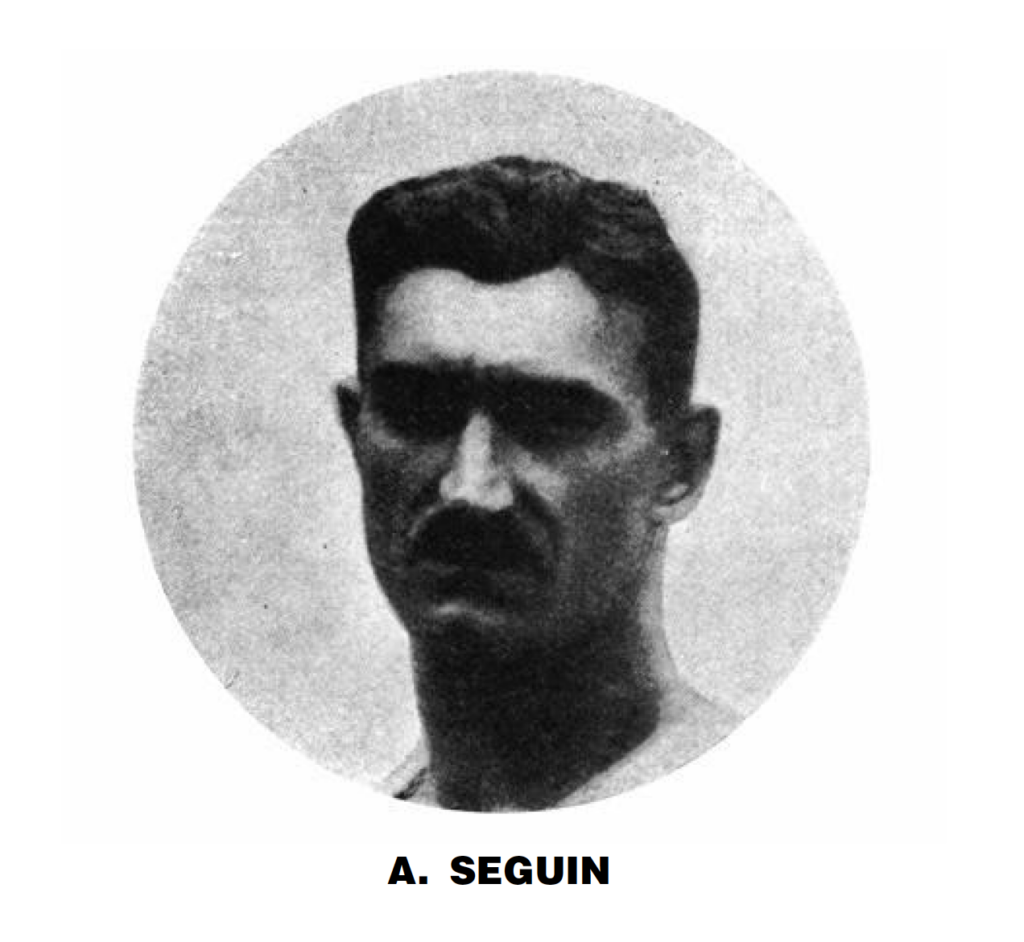
On what event did Séguin score a 10?
On the side horse compulsory vault.
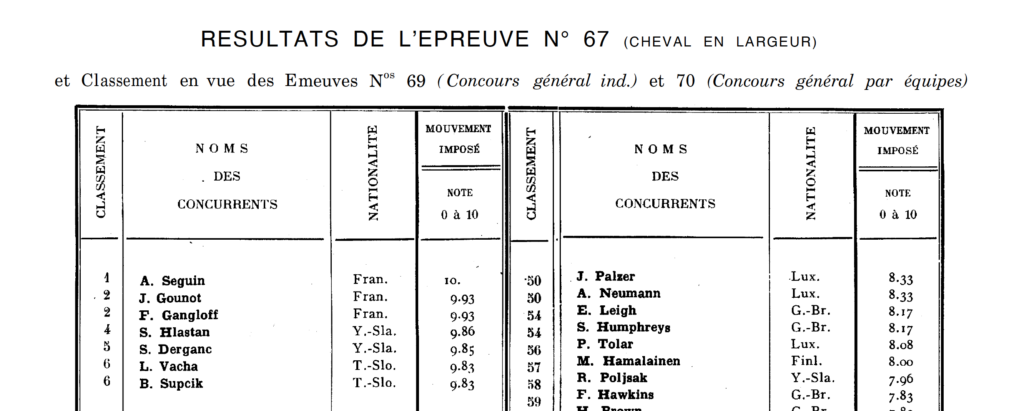
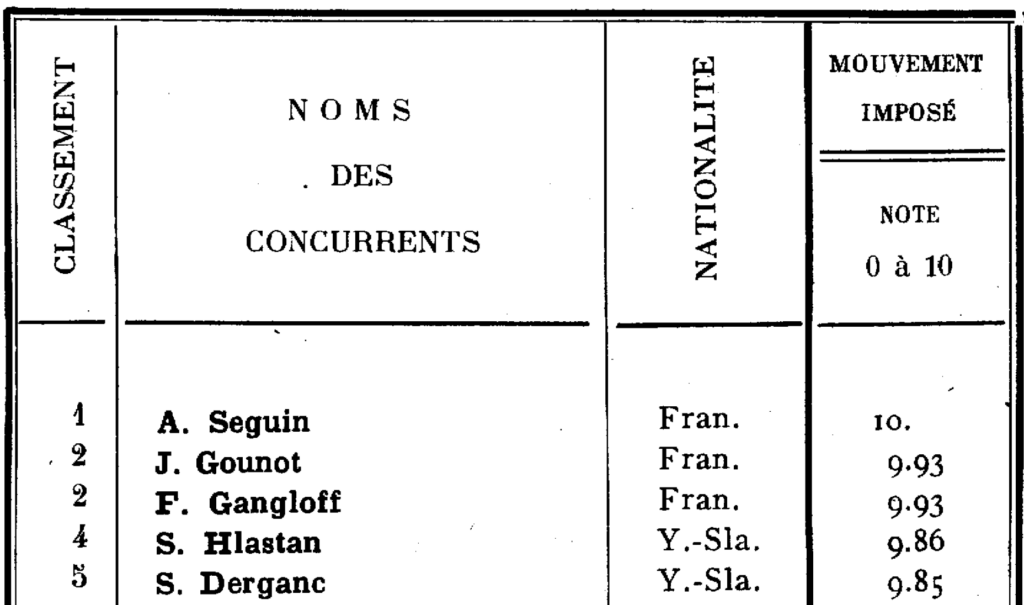
The gymnasts competed compulsory routines on:
- Horizontal Bar
- Parallel Bars
- Rings
- Pommel Horse
- Long Horse Vault
- Side Horse Vault
They also competed optional routines on:
- Horizontal bar
- Parallel Bars
- Rings
- Pommel Horse
And there was a timed rope climb.
From the French Olympic Committee’s report on the 1924 Games:
The program included a compulsory exercise and a free exercise on each of the usual large apparatuses (horizontal bar, parallel bars, rings, and pommel horse), a long horse vault, a side horse vault, and a fast rope climb.
Le programme comportait un exercice imposé et un exercice libre à chacun des grands engins usuels (barre fixe, barres parallèles, anneaux et Cheval-arçons), un saut au cheval en longueur, un saut au cheval en largeur et un grimper de corde en vitesse.
Jeux de la VIIIeme Olympiade Paris 1924: Rapport Officiel du Comité Olympique Français
What was the compulsory routine on side horse vault?
A front handspring
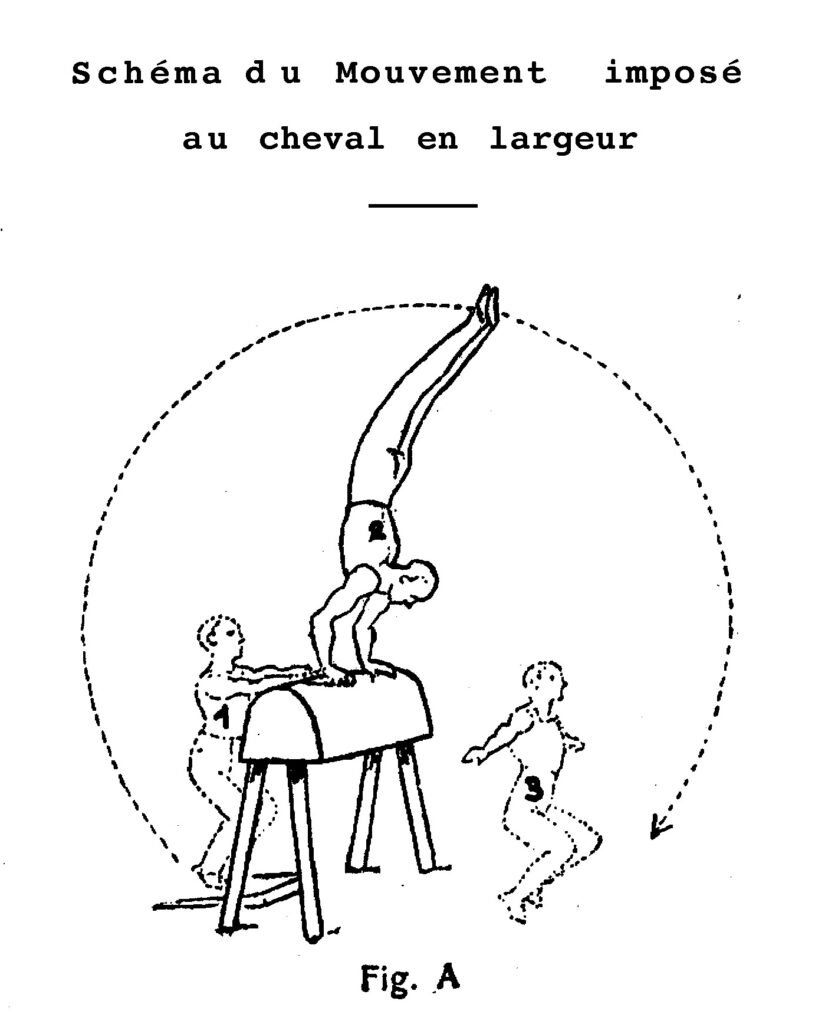
It was considered the least difficult routine of the program:
The side horse vault certainly offered the least difficulty of the whole program. All of the competitors, except one or two, got by without too much difficulty; but it must be said, there was too much variety in style and sometimes, if the ((passage)) of the horse was performed, it was still not a real vault.
Le saut au cheval en largeur offrait certainement la moindre difficulté de tout le programme. Tous les concurrents, sauf un ou deux, s’en tirérent sans trop de mal; mais il faut le dire, il y eut trop de diversité de style et parfois, si le (( passage )) du cheval était effectué, ce n’était tout de même pas un véritable saut.
Jeux de la VIIIeme Olympiade Paris 1924: Rapport Officiel du Comité Olympique Français
How was the side horse vault judged?
Points awarded to each of the compulsory exercises, except the rope climb and the long horse vault:
0 points for non-execution;
2 points for faulty execution;
4 points for mediocre execution;
6 points for satisfactory execution;
8 points for good execution;
10 points for perfect execution.
Points attribués à chacun des exercices imposés, excepté pour la corde lisse et le cheval en longueur:
0 point pour non-exécution ;
2 points pour exécution défectueuse ;
4 points pour exécution médiocre ;
6 points pour exécution satisfaisante ;
8 points pour exécution bonne ;
10 points pour exécution parfaite.
Programmes et règlements, 1924
So, indeed, it was a perfect 10.
What was written about Séguin?
He was a handsome/fine gymnast who moved elegantly and achieved the “maximum” score:
Only one maximum was awarded to the Frenchman SEGUIN, a very handsome gymnast with great elegance of movement, who was also the winner of the event. The first three places went to the French, who thus had the glory, unfortunately rare in all the Games, of seeing the three colors float on the Stadium, when the results were announced.
Un seul maximum fut accordé, au Français SEGUIN, trés beau gytmnaste d’une grande élégance de mouvements, qui fut d’ailleurs le vainqueur de I’épreuve. Les trois premiéres places revenaient aux Français qui eurent ainsi la gloire, rare hélas dans l’ensemble des Jeux, de voir flotter les trois couleurs sur le Stade, lors de la proclamation des résultats.
Jeux de la VIIIeme Olympiade Paris 1924: Rapport Officiel du Comité Olympique Français
Note: There would be debate over whether a 10 should be a “maximum” score or a “perfect” score. As we saw in the rules above, it was considered “perfect” execution. The same language (l’exécution parfaite) would appear in the 1949 Code of Points.
Were there any other 10s?
Technically, yes. The 8-meter rope climb was scored — not judged — out of 10. The following gymnasts received a 10:
- B. Šupčík, TCH
- A. Seguin, FRA
- A. Güttinger, SUI
- L. Vácha, TCH
- S. Zilic, YUG
- J. Gounot, FRA
- A. Hermann, FRA
- I. Porenta, YUG
- F. Kriz, USA
- M. Lertora, ITA
- L. Štukelj, YUG
- J. Pearson, USA
- F. Martino, ITA
- L. Delsarte, FRA
- F. Safanda, USA
- M. Wandrer, USA
- R. Pražák, TCH
- L. Cambiaso, ITA
- V. Lucchetti, ITA
- F. Mandrini, ITA
- H. Grieder, SUI
- B. Mořkovský, TCH
So, if you want to get technical, Comăneci wasn’t even the second gymnast to receive a 10 in Olympic history.
However, we are comparing apples and oranges. The rope climb was a timed event rather than an aesthetically judged event. The cut-off time for a 10 was 9 seconds:
Twenty-two competitors, out of the total of sixty, obtained a score of 10, that is to say that their time was between 7” 1/5 and 9 seconds.
Vingt-deux concurrents, sur le total de soixantedix, obtenaient la note 10, c’est-a-dire que leur temps était compris entre 7” 1/5 et 9 secondes.
Jeux de la VIIIeme Olympiade Paris 1924: Rapport Officiel du Comité Olympique Français
Séguin was the only gymnast to receive a 10 on an aesthetically judged event.
Note: U.S. gymnasts competed the rope climb through 1962 at the AAU Nationals:
These two events [flying rings and rope climb] will be dropped from National competition after this year due to lack of interest in the events. This lack of interest stems from an increased emphasis on the international or All-Around events at all levels of competition.
Modern Gymnast, May/June 1962
When a reader wrote in asking why gymnasts didn’t do the rope climb anymore, the editors of Modern Gymnast indicated that it should be a track and field event:
Our personal feelings are that, although Rope Climbing is a wonderful early training aid for Gymnastics, body conditioning and physical fitness, as a competitive event it belongs in Track and Field. We fully recognize wonderful part and glories past history Rope Climbing has played in competitive Gy mnastics especially in the high schools. However we truly believe that if accepted by Track and Field where it would be more at home with events that stress height, speed, distance and timing the future achievements and popularity of Rope Climbing would far surpass its past association as a Gymnastics event.
Modern Gymnast, February 1964
Tidbits about Gymnastics at the 1924 Olympics
The Participating Countries
- Yugoslavia
- United States
- Finland
- Great Britain
- Italy
- Switzerland
- Czechoslovakia
- France
- Luxembourg
The Stadium Layout
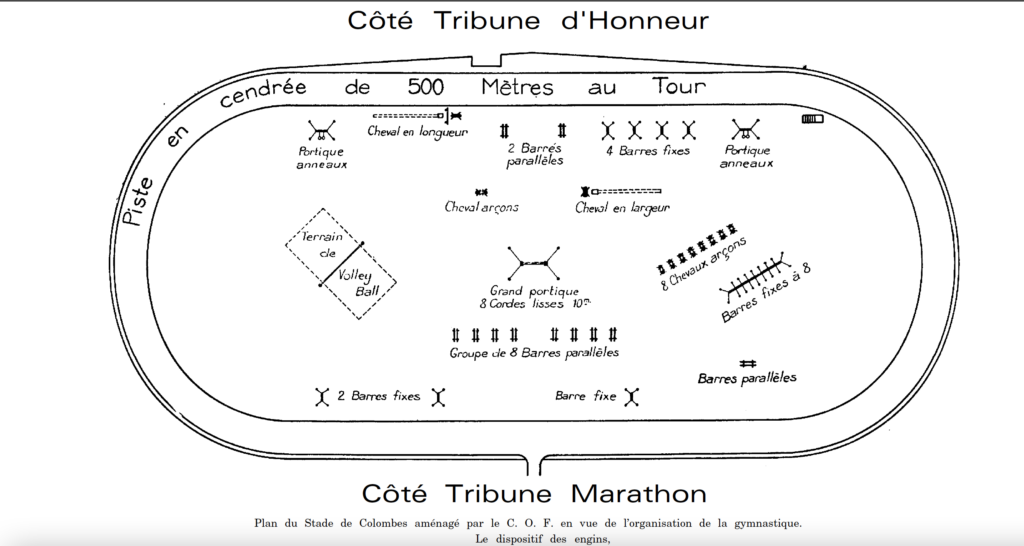
Volleyball was in the same area as gymnastics.
Teams could bring their own equipment, but they had to share it.
The official apparatuses had been installed by the Organizing Committee, but each of the teams was authorized to use its own apparatuses, on condition that they were made available to other nations who wished to use them; that is to say that the variety was great and that it constituted a real exhibition of the most modern models.
Les appareils officiels avaient été installés par les soins du Comité d’organisation, mais chacune des équipes fut autorisée à utiliser ses propres engins, à la condition de les tenir à la disposition des autres nations qui le désireraient; c’est dire que la variété en était grande et qu’elle constituait une véritable exposition des modèles les plus modernes.
Jeux de la VIIIeme Olympiade Paris 1924: Rapport Officiel du Comité Olympique Français
What could go wrong with an outdoor stadium?
For the most part, the weather wasn’t a problem — until it started raining on the gymnasts on high bar.
The atmospheric conditions were quite satisfactory for the whole of the competition: slightly cloudy, normal temperature, except however towards the end of the first day, which saw a sudden lowering of the thermometer, accompanied by violent gusts of wind with a few showers finally coming down.
Unfortunately, the teams that were at work (on the horizontal bar) at the time suffered the inconvenience.
Les conditions atmosphériques furent assez satisfaisantes pour l’ensemble du concours: ciel légèrement couvert, température normale, sauf cependant vers la fin de la première journée, qui vit un abaissement subit du thermomètre, accompagné de rafales violentes de vent que quelques ondées vinrent enfin abattre.
Malheureusement, les équipes qui étaient au travail (à la barre fixe) à ce moment, en subirent les inconvénients.
Jeux de la VIIIeme Olympiade Paris 1924: Rapport Officiel du Comité Olympique Français
My thought bubble: I guess the rainy high bar scene from the movie American Anthem had some basis in reality.
What were the rest of the compulsory routines?
Horizontal Bar
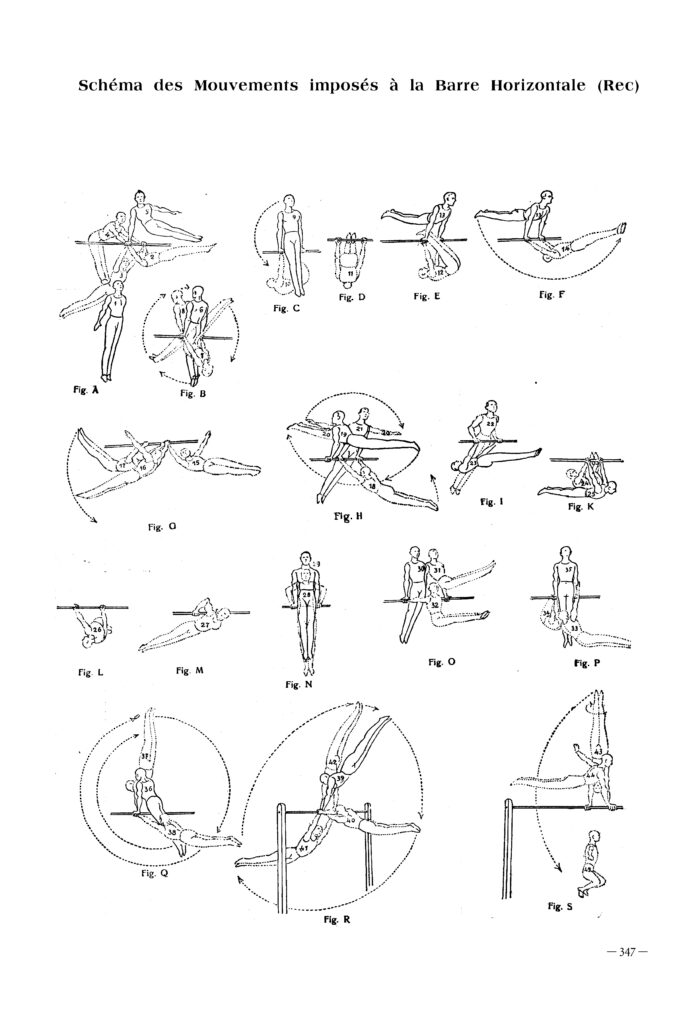
Parallel Bars
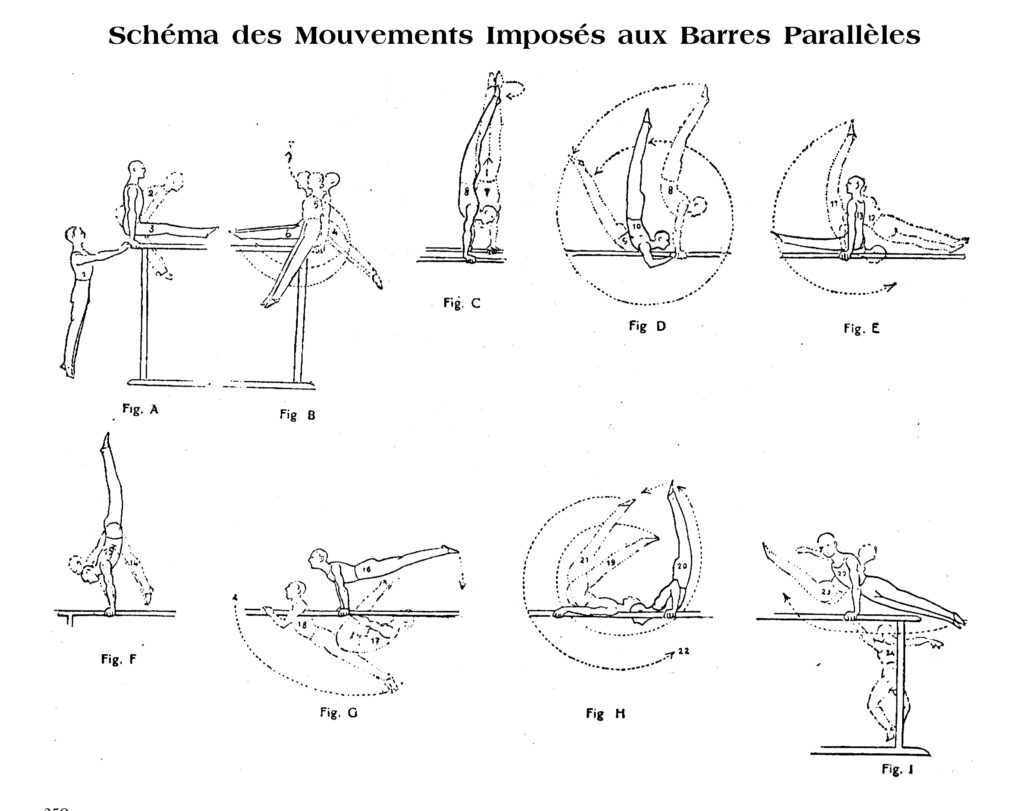
Rings
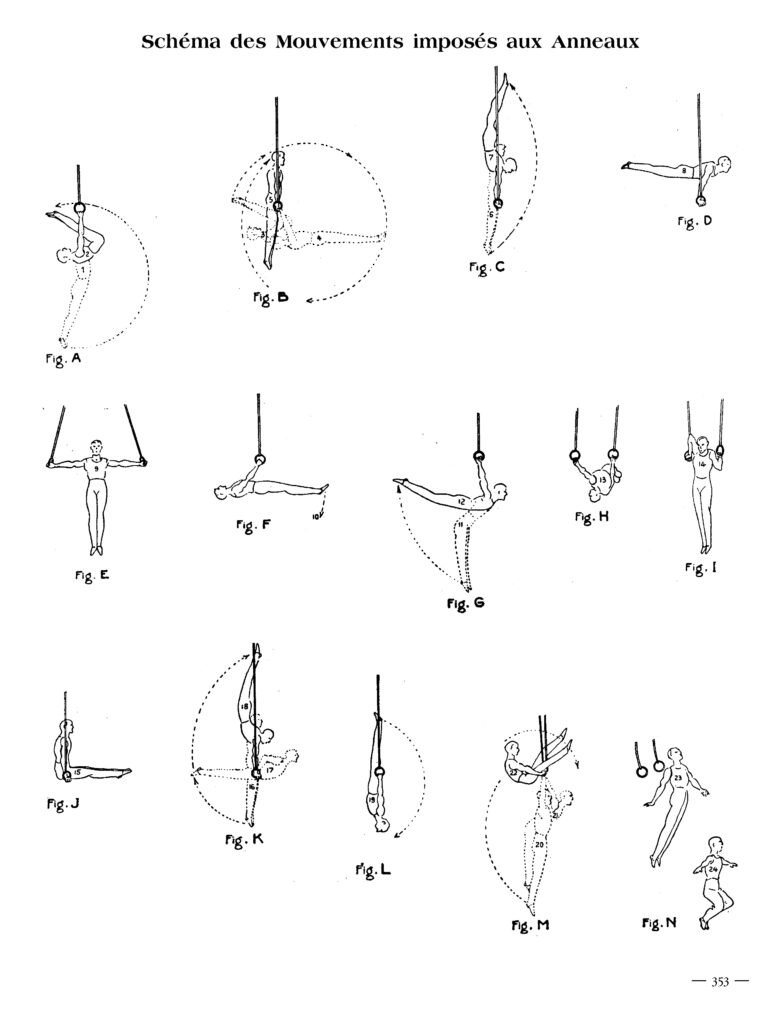
Pommel Horse
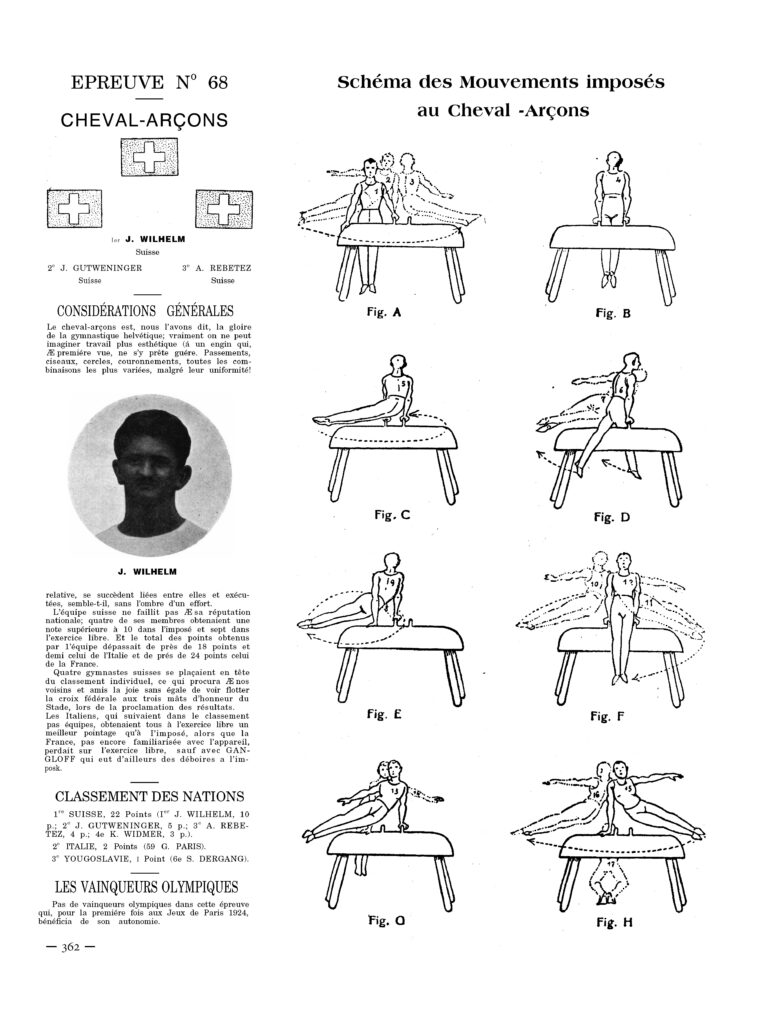
Long Horse Vault
Essentially, long horse vault was long horse vault + high jump from track and field. You can see photos below.
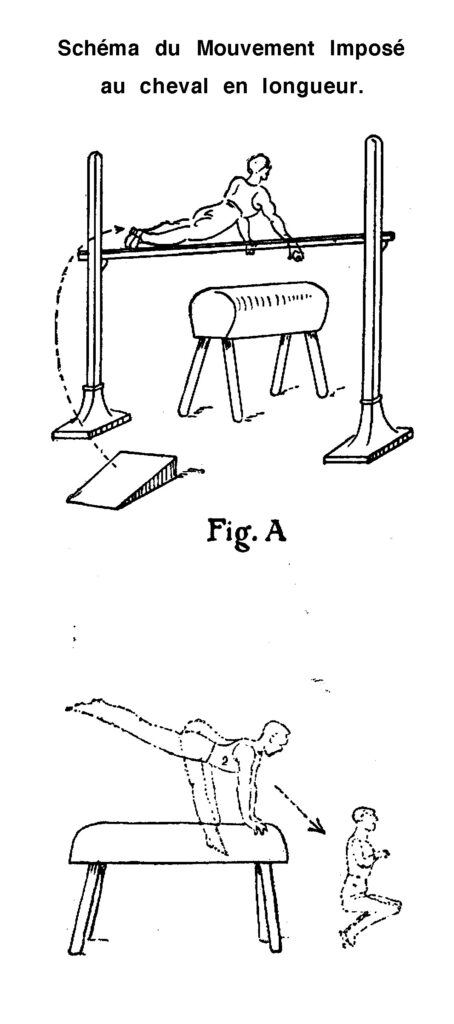
Note: This isn’t how gymnasts always competed long horse vault at the time. Here’s an image of various vaults in 1924 from Les Jeunes, the official publication of the Fédération Gymnastique et Sportive des Patronages de France.
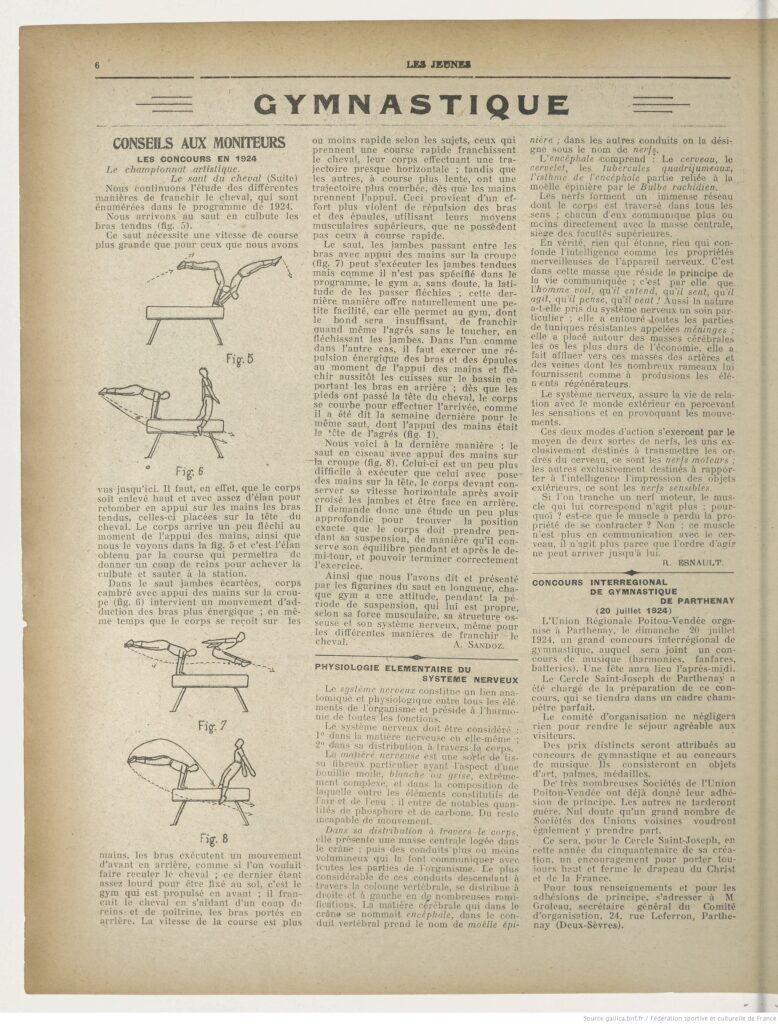
Notice the lack of a high jump bar.
How was the quality of the judging?
Somewhat biased nationalistically. Somewhat inexperienced.
On the whole, the jurors conscientiously performed their duties; some were more severe, more demanding, but their attitude was constant and their judgment equal from beginning to end. Taking into account the tendency – alas very human – to be a little generous for its own nationals, the significant differences of scoring must take into account an insufficiently thorough knowledge of the matter being judged, which was, to some degree, fatal with judges called upon to work? for the first time in an international event of this importance.
Dans l’ensemble, les jurés ont consciencieusement rempli leur tâche; quelques-uns se montrèrent plus sévères, plus exigeants, mais leur attitude fut constante et leur jugement égal du commencement à la fin. En tenant compte de la tendance — hélas bien humaine — d’être un peu généreux pour ses propres nationaux, les divergences sensibles d’appréciation doivent être surtout mises au compte d’une connaissance insuffisamment approfondie de la matière jugée, ce qui était en quelque sorte fatal avec des juges appelés à fonctionne? pour la première fois dans une épreuve internationale de cette importance.
Jeux de la VIIIeme Olympiade Paris 1924: Rapport Officiel du Comité Olympique Français
Scoring took a while.
Sometimes determining the score took a while; this was due a lot to the judges’ difficulty understanding each other because of the different languages spoken, and this was mainly due to the few delays observed and the sometimes slow pace of the competition.
Quelquefois, la détermination de la note prenait un certain temps; cela tenait beaucoup à la difficulté de se bien comprendre entre jurés de langues diverses, et c’est à ce fait qu’étaient dus surtout les quelques retards constatés et l’allure parfois un peu lente de la compétition.
Jeux de la VIIIeme Olympiade Paris 1924: Rapport Officiel du Comité Olympique Français
Note: Language barriers would continue to be a problem. Judges would eventually be able to use interpreters. From the 1968 Men’s Code of Points:
If within a group of judges a language barrier exists which makes necessary conversation impossible, the meet organizer is obliged to supply the necessary translating personnel. It is, however, desirable that in the case of larger meets such as world championships or Olympic Games, judges be chosen who, along with the necessary subject knowledge, also possess knowledge of one of the languages recognized by the FIG.
If a judge or superior judge brings a translator to assist him, the translator’s work is limited to translating and he is forbidden to influence the superior judge or judge in any manner. Translators for superior judges are permitted to sit next to them, while translators for judges may not sit next to them but only in their proximity in such a manner that when needed they may be called to their work without loss of time.
1968 Code of Points, Article 11, 4 & 5
Who were the judges?
High Bar – Compulsories
Smertnik (YUG); Bojus (USA); Ojander (FIN)
High Bar – Optionals
Parker (GBR), Alberti (ITA), Huguenin (SUI)
Parallel Bars – Compulsories
Havel (TCH), Paillot (FRA), Birtz (LUX)
Parallel Bars – Optionals
Kuscer (YUG), Ronzoni (ITA), Latvio (FIN)
Rings – Compulsories
Mears (GBR), Boiti (ITA), Lerch (SUI)
Rings – Optionals
Muller (TCH), Pradairol (FRA), Hentges (LUX)
Pommel Horse – Compulsories
Jeras (YUG), Prentiss (USA), Koivuniemi (FIN)
Pommel Horse – Optionals
Matthews (GBR), Tassi (ITA), Vaterlaus (SUI)
Long and Side Horse Vault
Bilak (TCH), Sandras (FRA), Haas (LUX)
Rope Climb
Bukowsky (TCH)
Timers: Viallet (FRA), Richème (SUI)
Jury of Appeal
President: Morel (FRA)
Rubien (USA)
Palmros (FIN)
West (GBR)
Romano Guerra (ITA)
Thorin (SUI)
Urban (TCH)
Vasiê (YUG)
8-up-8-count was brutal for Czechoslovakia.
From the get-go, it was clear that Italy, Switzerland, Czechoslovakia, and France were the top contenders.
From the initial contact, even before the start of the competition, we could predict that the fight for the places of honor would take place between the teams of Italy, Switzerland, Czechoslovakia and France, which were the most homogeneous and certainly the best prepared.
Dès la première prise de contact, avant même le commencement des épreuves, on pouvait pronostiquer que la lutte pour les places d’honneur aurait lieu entre les équipes de l’Italie, la Suisse, la Tchécoslovaquie et la France, qui étaient les plus homogènes et certainement les mieux préparées.
Jeux de la VIIIeme Olympiade Paris 1924: Rapport Officiel du Comité Olympique Français
There were 8 gymnasts on each team with 8 counting scores, and once the competition started, gymnasts could not be replaced:
The teams consisted of eight men, who could not be replaced once the events started.
Les équipes Etaient de huit hommes, qui ne pouvaient plus être remplacés une fois les épreuves commencées.
Jeux de la VIIIeme Olympiade Paris 1924: Rapport Officiel du Comité Olympique Français
[The team all-around ranking] was established on the basis of the combined results of the eight team members from each nation, in each of the seven individual events. thatwere on the gymnastics program.
Son classement fut établi d’aprés les résultats totalisés des huit équipiers de chaque nation, dans chacune des sept épreuves individuelles qui figuraient au programme de la gymnastique.
Jeux de la VIIIeme Olympiade Paris 1924: Rapport Officiel du Comité Olympique Français
So, when two Czechoslovak gymnasts were injured, it took them out of contention for the team title:
But an unfortunate accident took away one of the best members from the Czechoslovaks who, in accordance with the regulations, could not replace the injured one, were thus forced to give up all chance in the team classification.
Mais un malheureux accident enlevait un de leurs meilleurs éléments aux Tchécoslovaques qui, conformément au règlement, ne pouvant remplacer le blessé, se voyaient ainsi contraints d’abandonner toute chance dans le classement par équipes.
Jeux de la VIIIeme Olympiade Paris 1924: Rapport Officiel du Comité Olympique Français
Note: The two Czechoslovak gymnasts (Stanislav Indruch and Josef Kos) were injured on parallel bars:
We must note the abandonment of Czechoslovakia, which saw their chances disappear due to the withdrawal of two of their teammates, S. INDRUCH and J. KOS, victims of minor accidents on parallel bars.
On doit remarquer l’abandon de la Tchécoslovaquie qui vit ses chances disparaître en raison du retrait de deux de ses équipiers, S. INDRUCH et J. KOS, victimes de légers accidents survenus au cours de l’épreuve des barres paralléles.
Jeux de la VIIIeme Olympiade Paris 1924: Rapport Officiel du Comité Olympique Français
Final Scores for the Team Competition
- Italy 839.058
- France 820.528
- Switzerland 816.461
- Yugoslavia 762.500
- United States 715.600
- Great Britain 637.700
- Finland 554.800
- Luxembourg 548.000
Final Scores for the All-Around
- Leon Štukelj, YUG, 110.340
- Robert Pražák, TCH, 110.323
- Bedřich Šupčík, TCH, 106.930
- Ferdinando Mandrini, ITA, 105.583
- Miroslav Klinger, TCH, 105.500
- Ladislav Vácha, TCH, 105.300
Side note: According to the official report of the French Olympic Committee, the Swiss hardly practiced rings (“Les anneaux, peu pratiqués jusqu’alors en Suisse”). And pommel horse was “the glory of Swiss gymnastics” (“le cheval-arçons, gloire de la gymnastique helvétique”)
They checked IDs to make sure teams didn’t swap in and out gymnasts.
Intense rivalry amounting almost to suspicion and calling for the director to carry and produce at each apparatus, identification cards with photographs of all members of his team, was somewhat of a surprise to us, for we are accustomed to accepting the guarantee of a competitor and team of fair play, but this rule may have been considered necessary because the actual competition covered a period of three days with opportunity for replacements unnoticed otherwise.
Roy E. Moore, American Olympic Committee’s Report
Age Limit
Technically, there wasn’t an age limit, according to the IOC statutes:
There isn’t an age limit for the competitors in the Olympic Games.
Il n’y a pas de limite d’âge pour les concurrents aux Jeux Olympiques.
Statuts du Comité International Olympique, 1924
The ages of the gymnasts ranged from 20 to 38.
At the lower limit, three were 20 years old and two 21 years old, while at the upper limit, one was 36 years old, two 37 years old, and one 38 years old. The majority ranged from 24 to 27 (seven of 24, six of 25, eight of 26 and ten of 27) and between 30 and 32 (five of 30, seven of 31, and six of 32).
A la limite inférieure, trois avaient 20 ans et deux 21 ans, tandis qu’à la limite supérieure, un comptait 36 ans, deux 37 ans et un 38 ans. La majorité s’échelonnait entre 24 et 27 ans (sept de 24 ans, six de 25, huit de 26 et dix de 27) et entre 30 et 32 ans (cinq de 30, sept de 31 et six de 32).
Jeux de la VIIIeme Olympiade Paris 1924: Rapport Officiel du Comité Olympique Français
Gymnasts tended to be older than the other competitors at the Olympics (“L’âge est donc plus élevé en moyenne que dans la plupart des autres branches athlétiques des Jeux.”)
On Women’s Participation
According to the IOC statutes, women were allowed to compete at the Olympics.
Women are admitted to the Olympic Games. The program will determine the events they can compete in.
Les femmes sont admises aux Jeux Olympiques. Le programme fixera les épreuves qu’elles pourront disputer.
Statuts du Comité International Olympique, 1924
However, women did not compete in gymnastics at the 1924 Olympics.
On Scoring the Compulsory Routines
Points awarded to each of the compulsory exercises, except the rope climb and the long horse vault:
0 points for non-execution;
2 points for faulty execution;
4 points for mediocre execution;
6 points for satisfactory execution;
8 points for good execution;
10 points for perfect execution.
Points attribués à chacun des exercices imposés, excepté pour la corde lisse et le cheval en longueur:
0 point pour non-exécution ;
2 points pour exécution défectueuse ;
4 points pour exécution médiocre ;
6 points pour exécution satisfaisante ;
8 points pour exécution bonne ;
10 points pour exécution parfaite.
Programmes et règlements, 1924
In addition, for high bar, parallel bars, rings, and pommel horse:
1/2 point per gymnast for going to the apparatus
1/2 point per gymnast for returning from the apparatus
1/2 point par gymnaste pour aller à l’engin, et
1/2 point par gymnaste pour revenir de l’engin
Programmes et règlements, 1924
Elsewhere in the rules:
Decimal fractionation at 1/10 of a point will be applied: 0.10, 0.20, 0.30 points, etc.
Le fractionnement décimal au 1/10 de point sera appliqué : 0,10, 0,20, 0,30 points, etc.
On Scoring the Optional Routines
2 points for the beauty of the exercise
2 points for the originality and combination of the exercise
2 points for the difficulty and the intensity of the exercise
in addition 2 points for good execution
or 4 points for perfect execution
PLUS:
1/2 point per gymnast for the mounting of the apparatus
1/2 point per gymnast for the dismounting from the apparatus
–
2 points pour la beauté de l’exercice;
2 points pour l’originalité et la combinaison de l’exercice;
2 points pour la difficulté et l’intensité de l’exercice;
en plus 2 points pour l’exécution bonne
ou 4 points pour l’exécution parfaite.
PLUS:
1/2 point par gymnaste pour aller à l’engin, et
1/2 point par gymnast pour revenir de l’engin.
Programmes et règlements, 1924
Elsewhere in the regulations:
Decimal fractionation at 1/10 of a point will be applied: 0.10, 0.20, 0.30 points, etc.
Le fractionnement décimal au 1/10 de point sera appliqué : 0,10, 0,20, 0,30 points, etc.
Photos
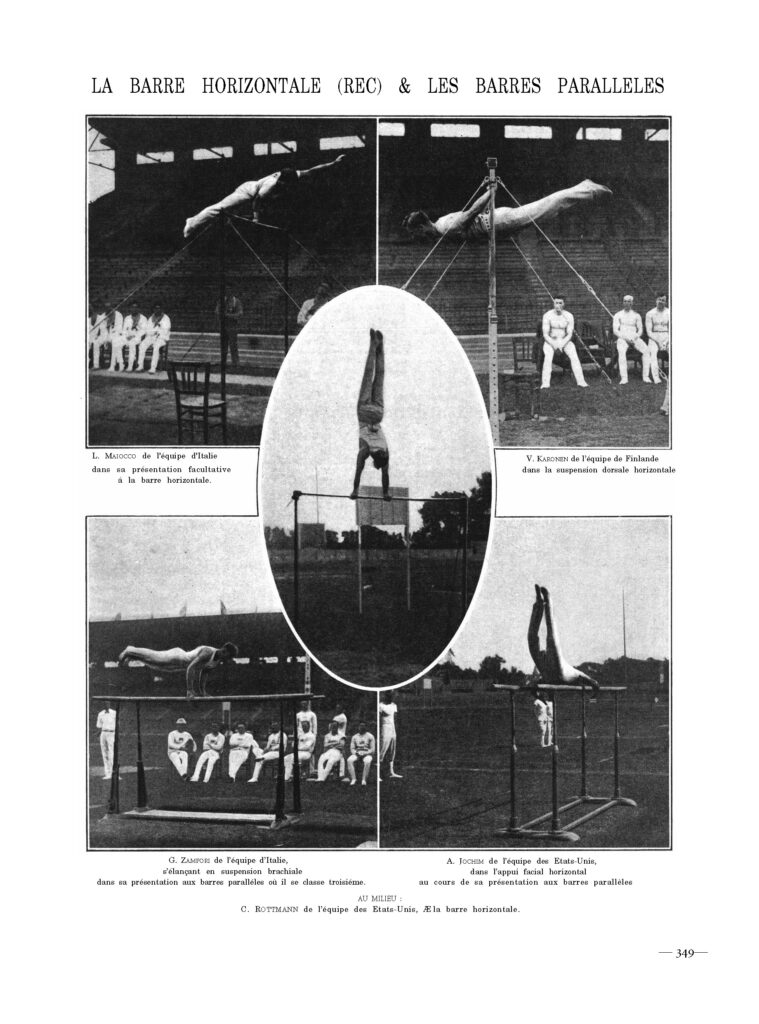
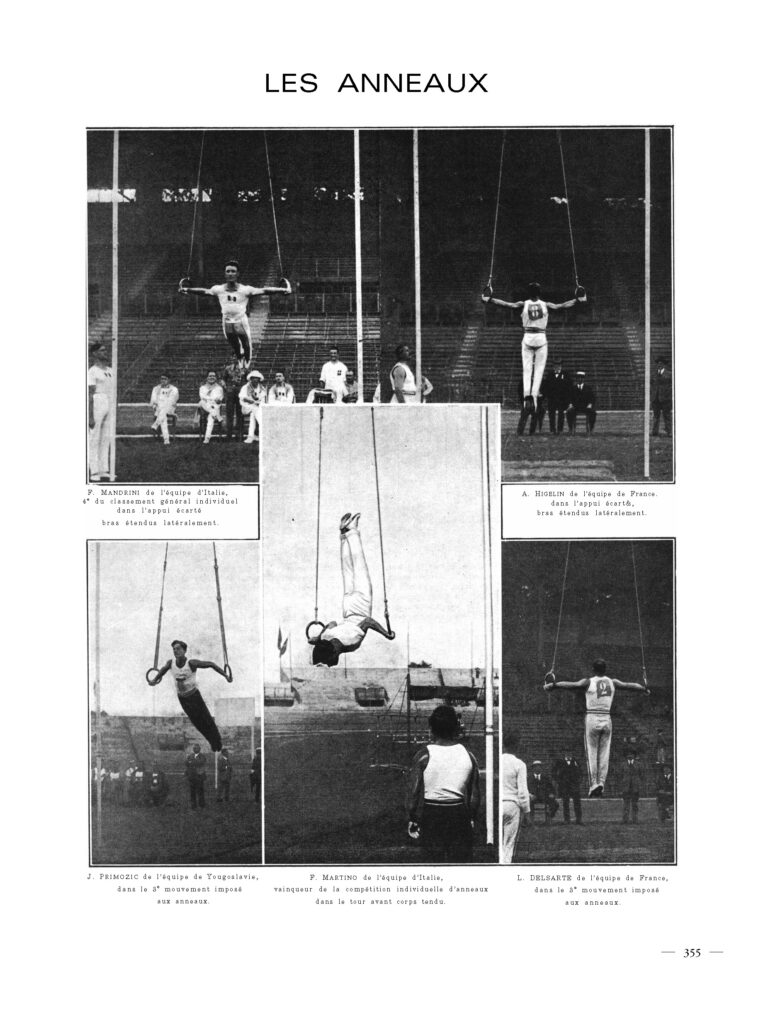
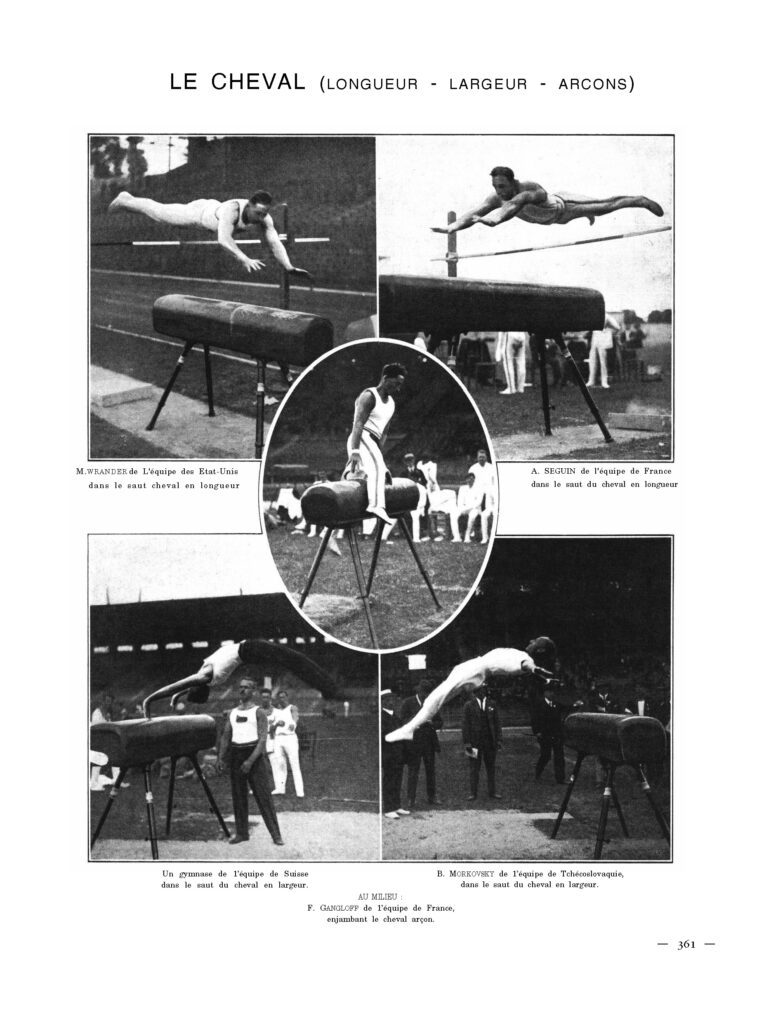
Apparatus Norms
Horizontal Bar
| Dimension | 1924 | 2021 |
| Height from Floor | 230 cm | 280 cm |
| Length | 220 cm | 240 cm |
| Diameter | 32 mm | 28 mm |
Parallel Bars
| Dimension | 1924 | 2021 |
| Height from Floor | 150 cm | 200 cm |
| Width between Bars | 42 cm | 42 to 52 cm |
| Handrail Thickness | 50 mm x 48 mm | 50 mm x 40 mm |
| Handrail Length | 280 cm | 350 cm |
Rings
| Dimension | 1924 | 2021 |
| Height from Floor | 230 cm | 280 cm |
| Inner Diameter | 17.5 cm | 18 cm |
| Thickness | 22 or 23 mm* | 28 mm |
| Spacing | 50 cm | 50 cm |
Rope Climb
Dimensions: 8 meters
Thickness: 28 mm
Start: standing, taut manual suspension. Get on as quickly as possible without the help of your legs; maintaining the position of your legs as you like; at the arrival at the top, strike a stamp or a ringtone unquestionably announcing the height reached.
Départ : debout, suspension manuelle tendue. Monter le plus vite possible sans l’aide des jambes ; maintien des jambes à volonté ; à l’arrivée en haut, frapper sur un timbre ou sur une sonnerie annonçant sans conteste la hauteur atteinte.
Programmes et règlements, 1924
Side Horse and Long Horse
| Dimension | 1924 | 2021 |
| Length | 190 cm | 120 cm |
| Width | 40 cm | 95 cm |
| Height | 120 cm | 135 cm |
Vaulting Board
| Dimension | 1924 | 2021 |
| Length | 60 cm | 120 cm |
| Height at back | 13 cm | 22 cm |
| Height at front | 3 cm | 3 cm |
Pommel Horse
| Dimension | 1924 | 2021 |
| Length | 190 cm | 160 cm |
| Width | 40 cm | 35 cm |
| Height to Top of Pommels | 140 cm | 127 cm (115+12) |
| Pommel Spacing | 42 cm | 40 to 45 cm |
Documents
Note: Some of these documents are extremely long, so I made abridged versions with the most pertinent information about the gymnastics competition.
+